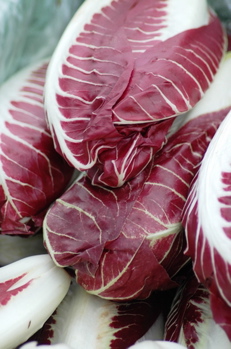Radicchio
 |
Radicchio adds a refreshingly spicy edge to salads and sandwiches |
Radicchio is a red, Italian leaf-chicory. It offers a spicy bitterness that can add a bite to dishes when used raw, or that can be tamed through grilling or roasting.
History
Radicchio has been around and appreciated for centuries. In his Naturalis Historia, Pliny the Elder made note of the health benefits of this leafy vegetable, and he also claimed that radicchio was first cultivated by the Egyptians, making its time of origin uncertain but epic.
Beginning on a large scale in fifteenth century Italy, radicchio cultivation quickly spiced up the lives of Medieval monks who were tired of their bland, generally-vegetarian diets. It was also favored by nobility who served it up cooked and raw.The radicchio eaten by Pliny and by the monks of the Middle Ages differed from that which we eat today. Cultivation of the modern radicchio plant didn’t begin until the late 1800s, after the Belgian agronomist Francesco Van den Borre engineered plants with the lush red-colored leaves and strikingly contrasting white veins. While the crunch and spice have been features of the radicchio throughout the ages, we have Van den Borre to thank for its culinary artistic value.
Varieties
Radicchio varieties get their names from the areas of Italy in which they were originally cultivated. Interestingly, some radicchio farmers in Veneto, Italy, have attempted to protect the names of their varieties, such as Tardivo, so that the names can only be used for the plants grown in their region under their supervision.Radicchio di Chioggia is most readily available in the United States, recognizable by its deep maroon color and its size and shape, which is comparable to that of a grapefruit.
The radicchio di Treviso is larger, almost football-shaped, and may sport a less intense coloring than the Radicchio di Chioggia.
Less common in the U.S. are the flower-like radicchios called Tardivo and radicchio di Castelfranco, which is a translucent white color.
Buying Tips
Seek the most strikingly vivid radicchio: deep reds complemented by the contrast of bright white veins. Overly soft leaves or noticeable blemishes usually indicate that the vegetable is past its prime.Storage Tips
Purchase radicchio right before you plan to use it. It’s hardier than other chicories, but its quality still diminishes quickly over just a few days in the refrigerator.To keep it for as long as possible, wash it and then dry it by shaking out the leaves, wrapping it in a damp cloth and keeping it in a cool location or the fridge crisper.
Don’t wrap it too tight, and be careful of any sort of airtight packaging, which will encourage rotting. The leaves need to “breathe.”
Usage Tips
In the United States, radicchio is most popular as a raw addition to salads or specialty sandwiches, both for its strong flavor and its unique decorative quality. Radicchio nicely supplements green salads, going particularly well with vinegar and vinaigrette dressings as well as gourmet cheeses.In Italy, home of the radicchio and scores of radicch





